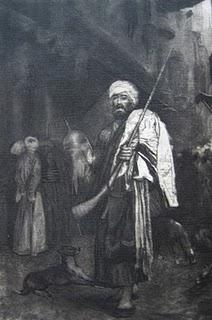 Thomas Moran, The Sounding SeaEtching, 1880
Thomas Moran, The Sounding SeaEtching, 1880Thomas Sidney Moran was born in Bolton, England, in 1837, but emigrated with his family to the USA in 1844, eventually settling in Crescentville, Pennsylvania. The young Thomas showed a talent for drawing, and was apprenticed to a Philadelphia wood-engraving firm, Scattergood and Telfer, from 1853-55, during which time Thomas learned to paint in oils and watercolour under the tutelage of his elder brother Edward Moran. In 1862 Edward and Thomas travelled to England, where their encounter with the art of Turner had a profound effect on Thomas Moran's artistic formation. Thomas Moran was elected an Academician of the National Academy of Design in 1884. Moran made his first etching in 1856, but did not take it up seriously until 1878. In all he made around 100 etchings, alongside his many paintings of the American landscape. He died in 1926.
 Mary Nimmo Moran, Conwy Castle, WalesEtching, 1885
Mary Nimmo Moran, Conwy Castle, WalesEtching, 1885As soon as Thomas had mastered the art he taught it to his wife, the artist Mary Nimmo Moran. Mary Nimmo was born in Strathavon, Scotland, in 1842, but emigrated to the USA in 1847. The Nimmo family settled in Crescentville, Pennsylvania. There Mary met Thomas Moran, five years her senior, who was the son of the Nimmo family's neighbours. Mary took art lessons with Thomas from the age of 18, and married him two years later. Homemaking and taking care of their three children stopped Mary continuing with her painting, but in 1879 Thomas taught her how to etch. Mary proved an apt pupil, and became celebrated as "the most prominent of the (American) women etchers in the late nineteenth century". Mary Nimmo Moran was elected to the Society of Painter-Etchers of New York, and was the only woman among the 65 original Fellows of the Royal Society of Painter-Etchers in London. John Ruskin was among those who collected and praised her prints, which were regarded by critics as on a par with those of her husband. Nevertheless Mary worked as M. Nimmo Moran, to avoid unsettling the buying public by declaring her gender too openly. From 1884 till her death from typhoid fever in 1899, Mary and Thomas Moran lived on Long Island, which furnished the motifs for many of Mary Nimmo Moran's etchings.
 Peter Moran, The Noonday RestEtching, 1877
Peter Moran, The Noonday RestEtching, 1877 Peter Moran, Landscape and CattleEtching after Émile van Marcke de Lummen, 1889
Peter Moran, Landscape and CattleEtching after Émile van Marcke de Lummen, 1889Peter Moran was the youngest of the three Moran brothers, born in 1841. Like his brothers, Peter Moran was born in England, but emigrated to the USA in 1844. Peter Moran was apprenticed at the age of 16 to the firm of lithographic printers Herline and Hersel, for whom he drew advertisements. The following year he began to study with his brothers Edward and Thomas. Peter Moran is particularly noted for his landscapes with cattle, which show the influence of Rosa Bonheur and Constant Troyon, and for his scenes of Pueblo life in New Mexico. Peter Moran was married to the artist Emily Moran, and taught painting and etching at the Philadelphia School of Design for Women. He died in 1914.
 Stephen J. Ferris, Mrs. Philip NicklinEtching after Gilbert Stuart, 1879
Stephen J. Ferris, Mrs. Philip NicklinEtching after Gilbert Stuart, 1879 Stephen J. Ferris, Mrs J. Coleman DraytonEtching after Daniel Huntington, 1881
Stephen J. Ferris, Mrs J. Coleman DraytonEtching after Daniel Huntington, 1881 Stephen J. Ferris, Devil's Way, AlgiersEtching after Adolphe Mouilleron, 1879
Stephen J. Ferris, Devil's Way, AlgiersEtching after Adolphe Mouilleron, 1879 Stephen J. Ferris, The Old-Clothes Dealer, CairoEtching after Jean-Léon Gérôme, 1880
Stephen J. Ferris, The Old-Clothes Dealer, CairoEtching after Jean-Léon Gérôme, 1880The influential Moran clan was further extended by the marriage of Elizabeth Moran, sister to the three brothers, to the artist Stephen J. Ferris. Stephen James Ferris was a highly-accomplished etcher who devoted himself chiefly to interpretational etchings of the paintings of others - or, at least, I haven't come across any original works by him. He was born in Plattsburg, N.Y., in 1835, and studied at the Pennsylvania Academy and then in Paris under Gérôme. Stephen and Elizabeth named their son after this teacher, and Jean Leon Gerome Ferris also became a notable etcher.

